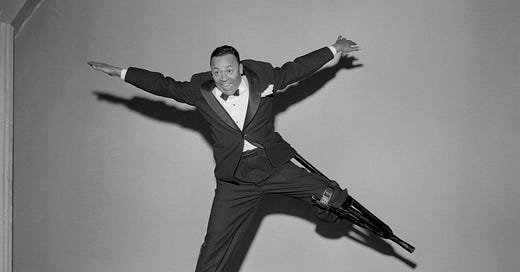Spotlighting The Brotha With a “Peg Leg”
The Indomitable Spirit of Clayton Bates and his Entertainment Footprint
I’d be tickled “Black” for you to join as a paid member supporter at $6.00/mo or $60.00/yr.
Your support will assist me in continuing to deliver world-class content to your inbox. In the meantime, let me know your thoughts about this article, already one of the most popular on “Black Books, Black Minds.”
One of the unique joys of immersing myself in non-fiction is what I like to call “side-discoveries.” These are the unexpected, fascinating detours into history that send you spiraling down a research rabbit hole.
Recently, while savoring Mark Whitaker's “Saying It Loud: 1966 – The Year Black Power Challenged the Civil Rights Movement,” I found myself captivated by just such a discovery. In the midst of the book’s rich narrative, Chapter 16, intriguingly titled “The Peg Leg Bates Purge,” introduced me to a figure whose life story is as extraordinary as it is inspiring.
Whitaker recounts a journey taken by civil rights activists, including the legendary Ella Baker, through New York’s Catskills Mountains. Their destination? The Peg Leg Country Club — a vibrant, Black-owned oasis amidst the predominantly Jewish summer resorts of the Borscht Belt.
The club's proprietor, Clayton “Peg Leg” Bates, was no ordinary entrepreneur. The son of a North Carolina sharecropper, Bates had risen to prominence as a tap-dancing virtuoso despite a childhood accident that left him with a wooden prosthetic leg.
Intrigued by this enigmatic figure, I paused my reading and plunged into research, eager to uncover more about the man behind the name. Clayton "Peg Leg" Bates was born on October 11, 1907, in Fountain Inn, South Carolina.
At the age of 12, a tragic accident at a cotton gin cost him his leg. Yet, where many would have seen an end, Bates saw only a beginning. He turned his wooden leg into a partner in rhythm, developing a unique tap dance style that defied both gravity and expectations.
Bates’s indomitable spirit took him to stages around the world, earning him recognition not merely as a disabled performer but as one of the greatest tap dancers of his time.
His fame extended to the small screen, where he became a regular on the Ed Sullivan Show, astonishing audiences with his precision, agility, and infectious energy. But what made him a legend was not just his ability to dance, but his refusal to be defined by his disability or his race.
In 1951, Bates expanded his legacy beyond the stage by founding the Peg Leg Bates Hotel and Country Club in Kerhonkson, New York. In an era marked by segregation and racial exclusion, this resort was a haven for Black Americans.
With amenities that included a swimming pool, tennis courts, golf facilities, and nightly entertainment, Bates created a space where Black families could vacation with dignity and joy. Here, under Bates's watchful eye, guests could revel in the simple pleasures of summer, laugh at the irreverent humor of Chitlin' Circuit comedians, and find a rare sense of belonging.
Mark Whitaker highlights this lesser-known chapter of Bates’s life, describing how by the mid-1960s, the resort had become a beacon of Black hospitality. Bates himself, known affectionately as “Peg,” was more than just a showman.
He was a shrewd businessman who turned a former turkey farm into a bustling retreat that welcomed thousands of Black vacationers. This venture was more than a business; it was an act of resistance, a bold assertion of Black autonomy and excellence in a world that often denied both.
Clayton "Peg Leg" Bates's story is not merely one of personal triumph over adversity. It is a testament to the power of resilience and vision. He broke barriers not only as a performer but as an entrepreneur, creating opportunities for others to experience leisure and luxury in a time when such experiences were often off-limits to people of color.
His life and work remind us that even in the face of profound challenges, it is possible to carve out spaces of joy, defy expectations, and leave an indelible mark on history.
In rediscovering Bates’s legacy, we are reminded that the dance of life is not just about the steps we take but about the rhythm we create, no matter the obstacles in our path. Bates danced his way into the hearts of millions, and his legacy continues to inspire — a compelling reminder of the boundless potential that lies within each of us to redefine what is possible.
Black Books, Black Minds” is a key foundation of my Great Books, Great Minds” passion project. For me, it’s a labor of love fueled by the endless hours of work I put into researching and writing these feature articles.
My aim is to ignite a new world of community, connection, and belonging through the rich trove of Black History books, thought leaders, and authors we unearth.
So if you are enjoying this digital newsletter, find it valuable, and savor world-class book experience featuring non-fiction authors and book evangelists on Black History themes, then please consider becoming a paid member supporter at $6.00/month or $60.00/year.






Wow. Truly inspirational on so many levels! Thank you for this post, Diamond-Michael. You know, I think I saw him on Ed Sullivan when I was a child. I was born in the 60s, so I was quite young, and my memories of much that I saw on television in those days are dim, at best, but the name “Peg-Leg Bates” immediately rang a bell, and the video felt oddly familiar. (That’s not something you see every day!) Of course, I had no idea of Mr. Bates' business acumen, which would be noteworthy even today, but under the circumstances and at that point in time? His wealth of achievements are indeed extraordinary!
Had no idea. Thanks for sharing his accomplishments. Another inspirational post.